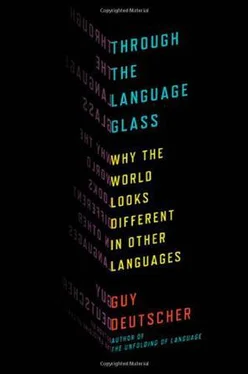The orientation skills of the Guugu Yimithirr: Levinson 2003, chs. 4, 6. On orientation skills of other Australian Aborigines, see Lewis 1976. On Tzeltal, see Brown and Levinson 1993.
strange sensation that the sun did not rise in the east: Levinson 2003, 128.
Jack’s shark story: Haviland 1993, 14.
Guugu Yimithirr spatial memory: Levinson 2003, 131.
The ongoing debate on the “rotating tables” experiments: See Li and Gleitman 2002; Levinson et al. 2002; Levinson 2003; Majid et al. 2004; Haun et al. 2006; Pinker 2007, 141 ff.; Li et al. (forthcoming). Many varieties of the rotating table experiments were conducted, and in most of them the subjects were not asked to “complete a picture,” as in the setup demonstrated here, but rather asked to memorize a certain order of objects and then “make it the same” on a different table. The “make it the same” instruction has attracted most criticism. Li et al. (forthcoming) argue that “make it the same” is ultimately an ambiguous instruction and that “in solving ambiguous rotation tasks, when the participant is asked to reproduce the ‘same’ spatial array or path as before, he or she needs to guess the experimenter’s intent as to what counts as the ‘same.’ To make this inference, people are likely to implicitly consult the way their language community customarily speaks about or responds to inquiries about locations and directions.” This criticism seems to me to be largely justified. However, the “complete the picture” experiment that I have presented above does not, as far as I can see, suffer from this problem, as it does not rely on the possibly vague and interpretable notion of “the same.” A further point of criticism by Li et al. that seems largely justified to me is against Levinson’s (2003, 153) claim that there is systematic downgrading of egocentric coordinates in the perception of Guugu Yimithirr and Tzeltal speakers. Li et al. did not find any evidence for such downgrading in the experiments they conducted with Tzeltal speakers. What is more, on the face of it, the downgrading claim is reminiscent of the Whorfian fallacy that the lack of a concept in a language necessarily means that speakers are unable to understand this concept. None of the claims made in this chapter rely on downgrading. Rather, they relate to the additional level of geographic computation and memory that Guugu Yimithirr and Tzeltal speakers are continually obliged to do and to the habits of mind that arise in consequence.
Jaminjung: Schultze-Berndt 2006, 103-4.
Yukatek: Majid et al. 2004, 111.
Hai||om orientation: See Neumann and Widlok 1996 and Widlok 1997.
Acquisition of geographic coordinates: De León 1994; Wassmann and Dasen 1998; and Brown and Levinson 2000. Some cultural artifacts may also contribute, of course. In Bali, for instance, houses are always built facing the same direction, the head of family always sleeps on the same side of the house, and children are always put in bed in a particular direction (Wassmann and Dassen 1998, 694).
The significance of the genders in Heine’s poem: Vygotsky 1987, 253, Veit 1976; and Walser 1983, 195-96.
“If I forget thee, O Jerusalem”: Heine quotes these lines in a letter to Moses Moser (Jan. 9, 1824) written not long after the poems were published: “Verwelke meine Rechte, wenn ich Deiner vergesse, Jeruscholayim, sind ungefähr die Worte des Psalmisten, und es sind auch noch immer die meinigen” (Heine 1865, 142).
“I also am a man of importance”: Bage 1784, 274.
Supyire: Carlson 1994.
Ngan’gityemerri: Reid 1997, 173.
Manambu: Aikhenvald 1996.
Underlying regularities in the distribution of genders in German: Köpcke and Zubin 1984.
The origin of gender systems: Claudi 1985; Aikhenvald 2000; and Greenberg 1978.
Loss of the genders in English: Curzon 2003.
“He that is become hoorse lately”: Brunschwig 1561, 14b-15a.
page 207 Dialectal uses of feminine nouns: Beattie 1788, 139, and Peacock 1877.
Femininity of “ship”: Strangely enough, “ship” is a relative newcomer on the gender ocean, for in Old English a scip was actually neuter, not feminine. So the use of a gendered pronoun here seems to be an actual case of personification, not just an old relic.
Experiment at the Moscow Psychological Institute: Jakobson 1959a, 237, and Jakobson 1972, 108.
German and Spanish comparisons: Konishi 1993.
French and Spanish comparisons: Sera et al. 2002.
Italian nonsense words: Ervin 1962, 257.
Boroditsky and Schmidt’s memory experiment: Boroditsky et al. 2003, but detailed results of the experiment based on Boroditsky and Schmidt (unpublished).
page 217 Japanese traffic lights: Conlan 2005. The official Japanese standard for green traffic lights shown in figure 7 is taken from Janoff 1994, and from the Web site of the Rensselaer Polytechnic Institute’s Lighting Research Center (http://www.lrc.rpi.edu/programs/transportation
/LED/LEDTrafficSignalComparison.asp). The official American standard is taken from Institute of Transportation Engineers 2005, 24.
Kay and Kempton’s experiment: Kay and Kempton 1984. More sophisticated experiments of this nature were carried out by Roberson et al. 2000, 2005.
Russian blues: Winawer et al. 2007.
The border between siniy and goluboy : This border (and for English speakers, the border between light and dark blue) was determined after the experiment for each participant separately. Each participant was shown twenty different shades of blue and asked to say whether each one was siniy or goluboy . English speakers were asked whether each shade was “light blue” or “dark blue.”
Left and right visual fields experiments: Gilbert et al. 2006. The results of this experiment inspired a spate of adaptations by different teams in different countries. See Drivonikou et al. 2007; Gilbert et al. 2008; and Roberson et al. 2008. All the subsequent tests corroborated the basic conclusions.
Broca’s area as a seat of language: Broca 1861. For a history, see Young 1970, 134-49.
MRI experiment: Tan et al. 2008.
EPILOGUE: FORGIVE US OUR IGNORANCES
Influence of language on thought can be considered significant only if it bears on genuine reasoning: See, e.g., Pinker 2007, 135.
APPENDIX: COLOR: IN THE EYE OF THE BEHOLDER
Color sensation in the brain: For further details on the anatomy of color vision, see Kaiser and Boynton 1996 and Valberg 2005.
“with only a little exaggeration”: Mollon 1995, 134. On the evolution of color vision, see also Mollon 1999 and Regan et al. 2001.
Memory affects perception of color: Hansen et al. 2006.
Adelung, J. C. Mithridates: Oder allgemeine Sprachenkunde . 1806-17. Intro. and ed. Johann Severin Vater. Berlin: Vossische Buchhandlung.
Aikhenvald, A. Y. 1996. Physical properties in a gender system: A study of Manambu. Language and Linguistics in Melanesia 27:175-87.
– -. 2000. Classifiers. Oxford: Oxford University Press.
Allen, G. 1878. Development of the sense of colour. Mind 3 (9):129-32.
– -. 1879. The colour sense: Its origin and development . London: Trubner.
Almquist, E. 1883. Studien über den Farbensinn der Tschuktschen. In Die wissenschaftlichen Ergebnisse der Vega-Expedition, ed. A. E. von Nordenskiöld, 1:42-49. Leipzig: Brockhaus.
Andree, R. 1878. Ueber den Farbensinn der Naturvölker. Zeitschrift für Ethnologie 10:324-34.
Bacon, F. 1861. The works of Francis Bacon, baron of Verulam, viscount St. Alban, and lord high chancellor of England . Vol. 2. Ed. J. Spedding, R. L. Ellis, and D. D. Heath. Boston: Brown and Taggard.
Читать дальше











